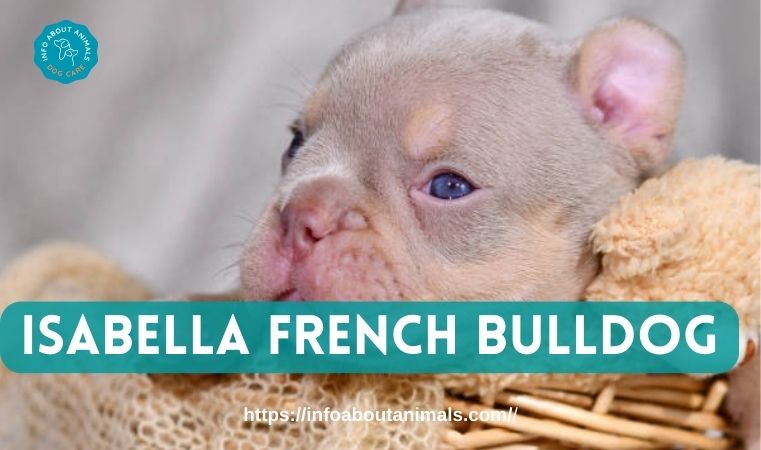Lilac Merle French Bulldog is a lovable breed derived from the beautiful lilac color which adorns its coat and is therefore remarkable. This conspicuous color avails itself through the genetic mixing of the blue and chocolate brown pigmentation. Beyond its magical coat, the Lilac Merle Frenchie features mesmerizing light-coloured eyes, frequently starting with bright blue puppy peepers, which may change shade as they mature.
Venturing into the Lilac Merle French Bulldogs world will be an interesting journey finding incredible information about this beautiful dog. Understanding their genetics will give a sneak peek into the wonders of their marvelous coat patterns and other aspects concerning their health. In interesting care and training tips, get a glimpse of how to care for the evolving friendship with the Lilac Merle Frenchie.
This article discusses its genetic makeup to shed light on where the lilac merle coat comes from. Also, we will discuss health aspects and give some practical tips about the keeping and training of these lovely animals so that you can take the best from every minute in the company of your Lilac Merle French Bulldog.
What is Lilac Merle French Bulldog
A Lilac Merle French Bulldog defines the breed that makes it confident amongst all others, as this is sure to be a certain color and pattern of the prevalent French Bulldog breed. This coat is distinctive due to the interplay of recessive and dominant genes.
The desired Lilac color in a French Bulldog requires two recessive genes inherited together. The first gene responsible for Dilution or Blue occurs at the D locus. This is a recessive gene whose presence entirely depends on both copies from the parents for it to become visible. If one of the Blue carrier breeds with a French Bulldog that doesn’t have this gene, then those parents will not bring forth the Blue offspring.
The second important gene regarded as the Cocoa gene is the chocolate gene. While there are two ways that a French Bulldog can carry the chocolate gene, it’s contributed to the Lilac colour only by the Cocoa gene. Just as with the Blue gene, a Chocolate color needs both parents to pass down a copy of the Cocoa gene so that the Lilac mutation can come up when mixed with the Blue gene.
Aside from the beautiful coloration, another attraction to the Lilac Merle French Bulldog is the visual patterning brought about by the Merle gene. The Merle gene appears in blotches of deeper fur throughout the coat, giving clear and sometimes a crooked pattern. Usually, these patches on the body are displayed as more prominent spots and can be observed in a much smaller size than that found around the face.
How can I tell if my Puppy is a Lilac?
DNA testing will be the most reliable method to know the color of your Puppy, Lilac, as this will be considered the gold standard for color confirmation. If in DNA, both the parents of the Puppy have been confirmed to be of the color, the same being Lilac, their pups will also inherit and present with the Lilac color.
When doing the DNA test, the genetic markers for a Lilac-colored puppy include Cocoa (Cocoa gene) and dd (Dilution/Blue gene). The small letters in dd mean that the latter genetic markers have no blue or dilution but represent Lilac coloring.
There are observable signs that give out the Lilac French Bulldog, more so in its facial appearance, but without the DNA testing. The most distinguishing eye colors for Lilac Frenchie puppies can be Blue, Light grey or Amber. Besides, their nose appears different from the usual solid black color and seems lighter greyish with pinkish patches around their eyes and mouth. While these visual cues can provide hints, they are not as definitive as DNA testing when used to confirm the coloration in a Lilac French Bulldog.
Physical Traits of the Lilac Merle French Bulldog
The Lilac Merle French Bulldog possesses this set of unique and striking physical features, making them truly one-of-a-kind and totally adorable.
Color and Coat:
Their most striking feature is the coat, which is in patches of dark color over a light base. The patches can be so small and close together to create an exciting effect on the dog, with many smaller patches on the face and bigger ones on the body. Their first distinctive characteristic is that their coat is short, sleek, smooth, glossy, and, therefore, easy to maintain.Additionally, many Lilac Merle French Bulldogs have light-colored eyes, enhancing their overall charm.
Size and Build:
These Bulldogs are generally about 11-12 inches tall and weigh around 16 to 28 pounds. They possess a prominent square-shaped head marked with heavy wrinkles and are decorated with large bat-like ears, adding character to their delightful great expressions. Their body is compact and muscular, showing both strength and agility.
In summary, the Lilac Merle French Bulldog is a small and sturdy bred dog with a kindling coat color and pattern that sets it apart from the rest of the others. Their head shape, including bat ears, not forgetting their muscular body, helps make them one of the most distinct and charming pets. Their shiny and short coat needs good caring and grooming to retain the appeal and attract attention.

Personality And Temperament
More than their color combination, Lilac Merle French Bulldogs are famous for maintaining a loving temperament flawlessly. Intelligent, friendly dogs like these are just the ticket for a loving family pet. Both of these breeds of dogs are very loyal to their owners and have such a human-minded nature that requires contact with humans. Expect your Lilac Merle Frenchie to be an unwavering and faithful companion, ready always to have your back. Their loving nature and strong bonds towards their human family ensure they thrive in a caring and attentive environment. But if you are searching for a little friend with good character and loving heart, the Lilac Merle French Bulldog will be a perfect variant.
Interaction With Children and Other Pets
Lilac Merle French Bulldogs usually get along well and are cordial to their environment. The latter includes children as well as other pets. Therefore, they are soft and friendly, which is a good fit in a family where such kids exist. However, it is essential that both the children be taught how to handle themselves towards dogs and also that they are supervised in all their playtime to keep off any incidents or misunderstandings.
These French Bulldogs can live along with other pets like cats without trouble. These early socializations will help them live peacefully in the same house with other animals. Gradual, controlled and supervised introductions to other pets go far towards alleviating the Lilac Merle Frenchie build positive experiences.
Though these dogs are generally good with other animals, it’s important to watch them and realize that the French Bulldogs sometimes have a strong drive to kill smaller animals. You will generally enjoy the friendly and sweet nature of your Lilac Merle French Bulldog family in a serene setting, including kids and other animals, provided proper introductions and supervision are done.
General Health Issues with this Breed
As with all French Bulldogs, prospective owners should know that Lilac Merle French Bulldogs are prone to several common health issues. Problems include the prevalent brachycephalic syndrome associated with this breed’s characteristic flat face, which may lead to breathing difficulty and heat sensitivity. They are also predisposed to skin problems, joint complications like hip dysplasia, and other health issues such as obesity, which only compound existing problems.
Furthermore, Lilac Merle French Bulldogs may be at an even greater risk for some genetic defects correlated to coat colorings, such as deafness and vision problems, given their abnormal coloration. Regular veterinary check-ups, a balanced diet and efficient exercise for his breed help him keep in good condition. Prospective owners need to ensure that they are dealing with responsible breeders who put the health and well-being of their dogs above all and take those necessary steps in genetic testing and screening to minimize the risk of hereditary issues.
Read Also: Big Rope French Bulldog
Are Lilac and Isabella the Same?
No, Lilac and Isabella are not the same color within French Bulldogs. Although they may look that way to the human eye, there is solid genetic evidence pointing to the fact that they are genetically distinct.
Lilac coloring ensues from the presence of the genes in the D Locus, that is, the Cocoa gene, also referred to as the Dilution or Blue gene. These are the combinations of the gene which give rise to Lilac coloration.
However, the basis for coloring with Isabella is tied to another set of genes found in the B Locus, sometimes called Testable Chocolate or Brown. This coloring differs from Lilac and is based on an independent genetic pathway.
Usually, a DNA test is the most accurate way to distinguish Lilac from Isabella accurately. It shows whether any genes of Cocoa are highly associated with Lilac or whether the genes and hence B Locus genes confirm that the dog should be identified as an Isabella. It’s interesting to notice that Isabella’s coat colour variation is far less common in French Bulldogs because Lilac predominates.
Do Kennel Clubs register Lilac Merle French Bulldogs?
Lilac Merle French Bulldogs face some hurdles when proposing registration by the Kennel Clubs, mainly due to their Lilac colour’s constitution and the Merle gene’s existence.
The Lilac is usually considered inappropriate for AKC registration due to being a “fad color” and falling out of the breed standard of French Bulldogs. The acceptance of these colors may change, but the AKC generally accepts Lilac. Moreover, French Bulldogs with the dilution gene (Blue gene) necessary for the Lilac colour achievement can be prone to other additional skin problems.
Another concern comes in; at times, health issues accompany the Merle gene. When Merle dogs get mated together, it is highly probable to get Double Merle offspring, which usually has its challenges with good health. Studies have shown that some Single Merles may exhibit hearing issues, and a single Merle gene can bring health risks. These health concerns can further act as roadblocks in getting the Merle French Bulldogs registered with the Kennel Clubs that favor breeds not forwarding such attributes as those for health and temperament.

Will a Lilac Merle French Bulldog Fit into Your Family?
Considering a Lilac Merle French bulldog into your new family adds charm and uniqueness to your household. The small dog’s lilac merle is a visually striking category, featuring captivating brownish chocolates and mixed blues to give attractive lilac color. Their light-colored, often blue eyes add to their appeal, making them a favorite among dog enthusiasts.
But still, it’s necessary to evaluate your family’s lifestyle before making such a decision. French Bulldogs, including Lilac Merles, are overall friendly and uncomplicated disposition stars. They quickly adopt family life with the households, children, and other pets. Because of their low exercise needs and apartment friendliness, they are perfectly suitable for busy families or cramped in the city living.
Plus, because they are adorable, one has to be aware of any severe health conditions that may come with the Merle gene. Responsible breeding practices are vital to avoid health issues like deafness or blindness in offspring. Ultimately, doing your homework and seeking out the best breeder possible, along with ongoing dedication to routine vet care and overall attentiveness, is crucial in ensuring that your Lilac Merle Frenchie lives a long and happy life by your side.
Conclusion
The Lilac Merle French Bulldog is an exceptional breed that is well sought after for its fascinating color pattern and easygoing and affectionate nature. While they might have some breed-related specific health problems, proper care, training, and socialization can shape them into wonderful family pets. It is essential to also work together with reputable breeders and veterinary experts for the overall health and happiness of your Lilac Merle French Bulldog.
With regular exercise, proper diet and necessary health precautions for these breeds, these dogs may lead complete and long lives as obedient pets. Good care from the owner through adopting specific needs and environment allows Lilac Merle French Bulldogs to prove themselves as a buddy of the owner’s family.
FAQs:
Are lilac merle French Bulldogs rare?
Yes, that is a rare color for lilac merle French Bulldogs. The gene isn’t natural in French Bulldogs and comes from mixing other breeds. Mirrored-fur Bulldogs aren’t purebred French Bulldogs, as breeders are adding genes as part of their breeding. The rare lilac coloration also results from the outcome of some specific breeding combinations. So, the combinations of both Lilac and merle in French Bulldogs are relatively a combination that is not so common.
What is a lilac Merle French Bulldog?
A lilac merle French Bulldog is a French Bulldog that displays a unique coat color pattern. The lilac coloration and trait merle pattern of the coating result from an impairment of pigmentation whereby patches of diluted pigment appear. That will make a very striking difference in appearance. That said, it is essential to note that the merle pattern is unnatural with French Bulldogs and can come with health issues.
What is the rarest merle color?
Further breeding for coat coloration produced another shade, sometimes called the rarest coloring of a merle, which is the merle color with the hue “champagne.” This shade usually has a beige or cream base with dark brown or grey patches. This variation is relatively newer and not much famed in the dog breeding fraternity, hence being of infrequent occurrence and highly sought color. However, it is essential to note that not all breeds of dogs manifest merle colors naturally, and their manifolds can be associated with specific health problems. As such, responsible and ethical breeding becomes an essential demand.
Is Merle’s color a fault?
Merle’s color is not a fault, but it is a genetic mutation and may have some health implications. The Merle gene changed how the pigment was spread through the coat and caused a marble or mottle pattern. But breeding two merles together can increase the risk of some health problems like increased risk of deafness, blindness, and other abnormalities. So, responsible breeding practices are then a must to minimize potential health issues.
Is Merle a bad gene?
It is not a bad gene but can have potential health implications. The Merle gene is, therefore, a natural genetic mutation that changes how pigment may be expressed in the dog’s coat and, thus, the color pattern produced. Breeding two merle dogs together may amplify the risk of specific health problems, including deafness, blindness, and other defects. Therefore, responsible breeding practices are necessary to minimize these potential health concerns.
References:
- Team, F. (2023, August 13). Lilac French Bulldogs: Rare and Beautiful Frenchie Variation. Fi. https://blog.tryfi.com/lilac-french-bulldog/
- Laukner, A., Truchet, L., Manukjan, G., Schulze, H., Langbein‐Detsch, I., Mueller, E., Leeb, T., & Kehl, A. (2021, July 19). Effects of Cocoa Genotypes on Coat Color, Platelets and Coagulation Parameters in French Bulldogs. Genes; Multidisciplinary Digital Publishing Institute. https://doi.org/10.3390/genes12071092
- French bulldogs have higher risk of 20 common health disorders. (n.d.). https://www.biomedcentral.com/about/press-centre/science-press-releases/16-12-21





